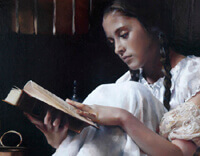The Lord of the Rings series by J. R. R. Tolkien
By Al R. Young
 |
| Reading List |
My experience with the stories of J. R. R. Tolkien began when I happened upon a copy of The Hobbit in the school library. I devoured its story of the finding of the ring, then read the epic trilogy, and went on in the hope that Smith of Wooten Major and Farmer Giles of Ham would somehow be seamless extensions of the story. I read The Silmarillion as soon as it was published, and have continued with only modest voracity to pursue the genius and artistry of Tolkien's work through a few of the many volumes published by his son.
I continue to read the trilogy for the beauty of its artistry. The characterizations do not, to my mind, even begin to be the studies of an Austen or a Trollope; instead, it is the world and the circumstances in which those characters find themselves caught up that seems to be the great preoccupation of the writer. It is a world in which Nature and the people in it are threatened by ignorance as well as the machinery of war. The characters have each a part to play which asks of them everything they can bring to the task; nevertheless, the great drama focuses not on their inner struggles, but whether each plays the part assigned.
In my own experience, while The Hobbit should be read at least once, the descriptive artistry of the trilogy bears repeated reading, and the remainder of the author's writings about these things are there for anyone who cannot quite get enough of Middle Earth. The author's ability to tell a tale is great, but it is his superlative ability to create a place that seems to me the greatest and most enduring of his genius.
We see that the characters in these stories struggle and change and are changed, but we see as though we were next to them in the struggle; one soldier to another, side by side in the trenches of the great wars of our time, perhaps so preoccupied with our own internal conflict that all we can do in terms of the characters in the story is fight side by side – undoubtedly as Tolkien did in World War I, and as anyone does who is caught up in the great struggles of life.
The story is very much the story of a world that was, a story of the hope that out of present victories, personal and otherwise, a more tenable world, if not a better, will yet emerge. The struggle may be that of the world at large, or the personal journey from childhood to adulthood, or that of a society traveling from farm to factory, from Nature to machine, from innocence to cynicism. Whatever the application of the story, it encourages the search and discovery of that which is good and beautiful and full of wonder; providing a lens through which to see the past, the present, and the future with fresh perspective.
Tags: 2010, Book reviews
Browse articles by year: 2025 . 2024 . 2023 . 2022 . 2021 . 2020 . 2019 . 2018 . 2017 . 2016 . 2015 . 2014 . 2013 . 2012 . 2011 . 2010 . 2009 . 2008 . 2007 . 2006 . 2005 . 2004 . 2003 . 2002 . 2001 . 2000 . 1999 . 1998 . 1997 . 1996
Browse articles by topic: Art lessons . BenHaven Archives . Blank art diaries . Fine art photography . Framing . Illustration . Inspiration and creativity . Isles of Rune . Limited Editions Collection . My Fathers Captivity . News . Novellas . Oil paintings and prints . Operations announcements . Orders and shipping . Overview . Portfolios . The Papers of Seymore Wainscott . Project commentaries . Recipes by Nancy Young . Recommended reading . Recommended viewing . Temple artworks . The Storybook Home Journal . Tips and techniques . Tools supplies and operations
Browse articles by topic: Art lessons . BenHaven Archives . Blank art diaries . Fine art photography . Framing . Illustration . Inspiration and creativity . Isles of Rune . Limited Editions Collection . My Fathers Captivity . News . Novellas . Oil paintings and prints . Operations announcements . Orders and shipping . Overview . Portfolios . The Papers of Seymore Wainscott . Project commentaries . Recipes by Nancy Young . Recommended reading . Recommended viewing . Temple artworks . The Storybook Home Journal . Tips and techniques . Tools supplies and operations